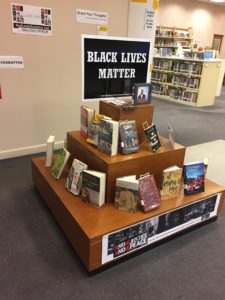Read to Understand: CML’s Black Lives Matter Reading List
When I arrive on the second floor of Charlotte’s Main Library, I notice the usual activity. Two librarians seated behind the reference desk, ready to answer questions. A couple of individuals shuffling through the bookshelves. A cluster of people seated at computer work stations.
 But there is also the sound of a soft quiet here—not silence, but quiet. The type of quiet I think floods a place where people have respect for the many ideas percolating in the presence of so much information.
But there is also the sound of a soft quiet here—not silence, but quiet. The type of quiet I think floods a place where people have respect for the many ideas percolating in the presence of so much information.
I take in these observations in a quick sweep of the room. Then words in the corner of my eye pull my gaze to the space near the elevator. “Unrest,” “K(no)w Justice, K(no)w Peace,” and “Hands Up, Don’t Shoot,” read the signs hanging on the wall. Interspersed with the words and phrases are black and white drawings of Walter Scott, Eric Garner, Philando Castile, Tamir Rice, Trayvon Martin, and Sandra Bland. Just above each of their names are the words, “Justice For.”
One sign frames the familiar phrase, “Black Lives Matter,” and rises above a book display. I pause and I stare. I stare at the words on the wall and the drawings of people no longer alive. I read their names in a hushed voice, barely above a whisper. Then I walk around the book display, nodding at titles I’ve already read, like Men We Reaped and The Fire This Time, and also noting the many books I don’t know.
Enlarged, photocopied book covers form a column at the edge of the wall. Recommended reading for those wondering where to start. Yellow call-out bubbles explain who might want to read each book suggestion.
“Feel defensive?” says the first call-out bubble. Then read What Does It Mean to be White by Robin DiAngelo.
“Think racism is a thing of the past?” Then read Between the World and Me by Ta-Nehisi Coates.
“Think you are ‘color blind’?” Then read Why Are All the Black Kids Sitting Together in the Cafeteria by Beverly Daniel Tatum.
“Think anyone can get ahead if they work hard enough?” Then read The New Jim Crow by Michelle Alexander.
Last autumn Angel Truesdale and her co-workers curated this display and created a reading list in response to the one-year anniversary of Keith Lamont Scott’s death—and also to support the new exhibit at the Levine Museum entitled, K(no)w Justice, K(no)w Peace. The library will keep the display up until the end of February. However, the suggested reading list is online now and will remain available.
The presence of this book display in the Main Library sends a powerful message to our community that these issues are important and we must engage. These voices and these stories matter, and we must not turn away despite the possibility of missteps and pain. If we want to seek authentic, genuine healing in our broken society, then we must understand the places our society came from and how those places gave birth to where we are today.
I am a black woman who often writes about the topic of race. When I look at this library display and read the suggested list, I experience a thrill at knowing I add my words to the words of many.
These curated books and other materials offer invitations to all of us. For some, these are invitations to find affirmation that people are using their voices to tell our stories. For others, these are invitations to discover another experience. In the act of accepting these invitations, we open ourselves up to the possibility of reimagining the future.
I again read the words taped to the wall. I look at the drawings of people who should still be alive. I touch the spines of books. The soft library-grade quiet present in the room allows me a moment of reverence as I stand before these books and this wall.
And I think this display whispers to me, “Your life matters.”
Patrice Gopo is a 2017-2018 North Carolina Arts Council Literature Fellow, and her essay collection about race, immigration and belonging will release this summer. Please visit patricegopo.com to read more of her work and sign up for updates about her book.
